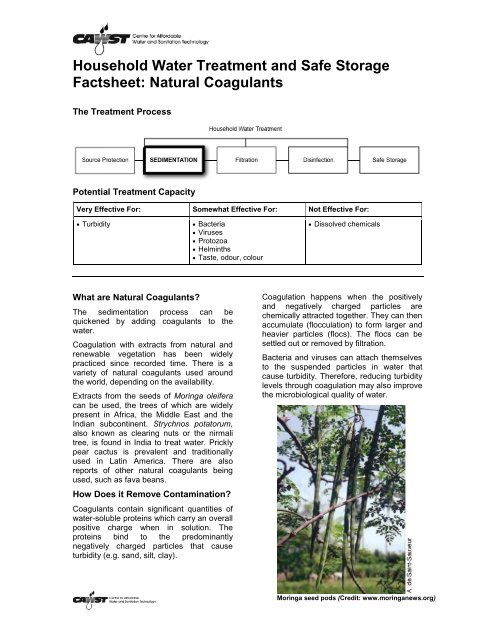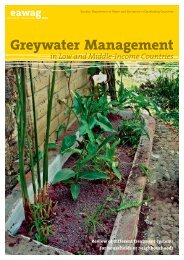Household Water Treatment and Safe Storage Factsheet: Source ...
Household Water Treatment and Safe Storage Factsheet: Source ...
Household Water Treatment and Safe Storage Factsheet: Source ...
Create successful ePaper yourself
Turn your PDF publications into a flip-book with our unique Google optimized e-Paper software.
<strong>Household</strong> <strong>Water</strong> <strong>Treatment</strong> <strong>and</strong> <strong>Safe</strong> <strong>Storage</strong><br />
<strong>Factsheet</strong>: Natural Coagulants<br />
The <strong>Treatment</strong> Process<br />
Potential <strong>Treatment</strong> Capacity<br />
Very Effective For: Somewhat Effective For: Not Effective For:<br />
Turbidity<br />
Bacteria<br />
Viruses<br />
Protozoa<br />
Helminths<br />
Taste, odour, colour<br />
Dissolved chemicals<br />
What are Natural Coagulants?<br />
The sedimentation process can be<br />
quickened by adding coagulants to the<br />
water.<br />
Coagulation with extracts from natural <strong>and</strong><br />
renewable vegetation has been widely<br />
practiced since recorded time. There is a<br />
variety of natural coagulants used around<br />
the world, depending on the availability.<br />
Extracts from the seeds of Moringa oleifera<br />
can be used, the trees of which are widely<br />
present in Africa, the Middle East <strong>and</strong> the<br />
Indian subcontinent. Strychnos potatorum,<br />
also known as clearing nuts or the nirmali<br />
tree, is found in India to treat water. Prickly<br />
pear cactus is prevalent <strong>and</strong> traditionally<br />
used in Latin America. There are also<br />
reports of other natural coagulants being<br />
used, such as fava beans.<br />
How Does it Remove Contamination?<br />
Coagulants contain significant quantities of<br />
water-soluble proteins which carry an overall<br />
positive charge when in solution. The<br />
proteins bind to the predominantly<br />
negatively charged particles that cause<br />
turbidity (e.g. s<strong>and</strong>, silt, clay).<br />
Coagulation happens when the positively<br />
<strong>and</strong> negatively charged particles are<br />
chemically attracted together. They can then<br />
accumulate (flocculation) to form larger <strong>and</strong><br />
heavier particles (flocs). The flocs can be<br />
settled out or removed by filtration.<br />
Bacteria <strong>and</strong> viruses can attach themselves<br />
to the suspended particles in water that<br />
cause turbidity. Therefore, reducing turbidity<br />
levels through coagulation may also improve<br />
the microbiological quality of water.<br />
Moringa seed pods (Credit: www.moringanews.org)
















